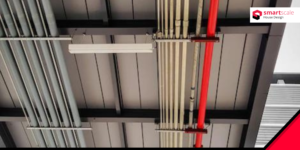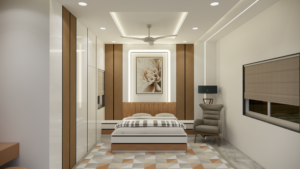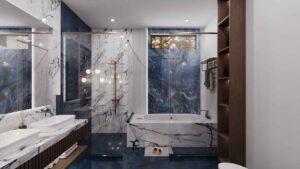When it comes to the design of an interior space, even the smallest details are important. Each component, from the flooring to the walls, helps to produce an environment that is unified and aesthetically pleasing in its entirety. The ceiling is a component of interior design that is frequently disregarded despite its significant impact. While the ceiling may seem like a simple overhead surface, incorporating false ceilings can bring numerous benefits in enhancing interior spaces. False ceilings, which can also be referred to as dropped ceilings or suspended ceilings, have become increasingly popular due to their capacity to modify the appearance of a room while simultaneously contributing to its usefulness. In this article, the best interior designer in Mumbai will discuss the numerous benefits that fake ceilings offer, as well as the ways in which they help to improve the general atmosphere as well as the operation of interior spaces.
False ceilings serve as a canvas for design possibilities and provide practical solutions to common design challenges. Whether it’s concealing unsightly fixtures, optimizing lighting design, or improving acoustic performance, false ceilings have become a valuable tool in interior design.
By incorporating false ceilings, interior spaces can achieve a clean and seamless look by concealing electrical wiring, plumbing, and air conditioning ducts. Furthermore, false ceilings contribute to optimizing lighting design by offering the flexibility to incorporate various lighting fixtures, creating a desired ambience and adding visual interest to the space.
Acoustic comfort is another important aspect of interior spaces, especially in areas with high noise levels. False ceilings aid in improving sound absorption, reducing echoes, and creating a quieter and more pleasant environment. Additionally, false ceilings provide an opportunity to integrate heating, ventilation, and air conditioning (HVAC) systems efficiently, ensuring optimal climate control and energy efficiency.
Maintenance and repairs are also made easier with false ceilings, as they provide easy access to concealed fixtures, saving time and minimizing disruptions. Moreover, false ceilings offer the possibility of concealed storage spaces, maximizing the use of vertical space and keeping the room organized and clutter-free.
- Concealing Unsightly Fixtures:
- False ceilings provide a practical solution for hiding electrical wiring, plumbing, and air conditioning ducts.
- Concealing these fixtures creates a clean and seamless appearance, enhancing the overall aesthetic appeal of the house plan design.
- Enhancing Acoustic Performance:
- False ceilings contribute to improving the acoustic comfort of a room by absorbing sound and reducing echoes.
- They help create a quieter and more peaceful environment, particularly in areas with high noise levels, such as offices, classrooms, or entertainment venues.
- Optimizing Lighting Design:
- False ceilings offer the opportunity to incorporate innovative lighting solutions, such as recessed lights, LED strips, or track lighting.
- By strategically positioning light fixtures within the false ceiling, designers can achieve various lighting effects and create ambience in different areas of the house plan design.
- Adding Visual Interest and Design Versatility:
- False ceilings come in a wide range of materials, textures, and patterns, allowing for creative design possibilities.
- Energy Efficiency and HVAC Integration:
- False ceilings can aid in improving energy efficiency by providing a space for insulation and reducing heat transfer.
- They also enable efficient integration of heating, ventilation, and air conditioning (HVAC) systems, ensuring optimal climate control within the house plan design.
- Easy Access for Maintenance and Repairs:
- False ceilings are designed with accessibility in mind, allowing easy access to concealed fixtures for maintenance or repairs.
- This simplifies the process of addressing issues with electrical, plumbing, or HVAC systems, saving time and minimizing disruption.
- Concealed Storage and Functional Spaces:
- False ceilings can be utilized to create concealed storage vastu house plan, such as overhead cabinets or shelves, maximizing the use of vertical vastu for home plan space.
- Additionally, they can be adapted to accommodate functional elements like speakers, projectors, or air vents in the vastu for home plan.
Conclusion:
False ceilings, with their myriad benefits, have emerged as a valuable tool in enhancing vastu house plan interior spaces. They offer a range of advantages that go beyond their aesthetic appeal, contributing to the overall ambience, functionality, and comfort of a room. False ceilings have become an essential component of contemporary interior design as a result of the many benefits they offer, including the ability to hide unsightly fixtures, improve acoustic performance, optimise lighting design, and provide easy access for maintenance.
One of the key benefits of false ceilings is their ability to hide electrical wiring, plumbing, and air conditioning ducts. This creates a clean and seamless appearance, allowing for a clutter-free environment and enhancing the overall aesthetic appeal of the vastu house plan space. Moreover, false ceilings provide a practical solution for integrating various lighting fixtures, enabling designers to create the desired ambience and add visual interest to the vastu house plan.
Acoustic comfort is another significant advantage offered by false ceilings. By absorbing sound and reducing echoes, they help create a quieter and more pleasant environment, particularly in areas with high noise levels. This is particularly beneficial for offices, educational institutions, and entertainment venues where noise control is crucial.
False ceilings also contribute to energy efficiency and HVAC integration. By providing a west-facing house plan with vastu space for insulation, they aid in improving thermal insulation and reducing heat transfer, thereby optimizing energy consumption. Additionally, false ceilings facilitate the efficient integration of heating, ventilation, and air conditioning (HVAC) systems, ensuring optimal climate control and enhancing energy efficiency.
Maintenance and repairs are simplified with false ceilings, as they offer easy access to concealed fixtures. This saves time and minimizes disruptions when addressing issues related to electrical, plumbing, or HVAC systems. Furthermore, false ceilings can provide concealed storage in a west-facing house plan with vastu spaces, maximizing the use of a vertical west-facing house plan with vastu spaces and helping to keep the room organized and clutter-free.
In conclusion, false ceilings bring a multitude of benefits in enhancing interior spaces. Whether it’s hiding unsightly fixtures, optimizing lighting design, improving acoustics, or providing easy maintenance access, they play a crucial role in creating visually appealing, functional, and comfortable environments. The versatility and design possibilities of false ceilings make them an invaluable addition to modern interior design projects, transforming spaces into aesthetically pleasing and well-optimized settings. Whether it’s a residential, commercial, or institutional west-facing house plan with vastu space, incorporating false ceilings can significantly enhance the overall experience and quality of the interior environment.









